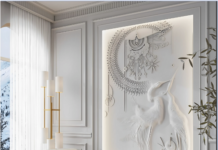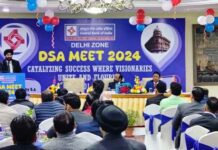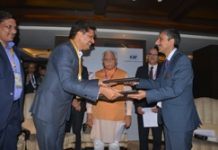New Delhi, January 03, 2017
Baluchari – Bengal and Beyond, Inauguration: 18th November, 2016 at 6:00 pm At Birla Academy of Art & Culture 108-109 Southern Avenue, Kolkata
Concept Design & Research By: Weavers Studio Resource Centre, In Association with Event Partner: Tantuja, Historical pieces By: Tapi Collection, Venue Support By: Birla Academy of Art & Culture and Field Trip Support By: Tourism Dept., West Bengal
Darshan Shah& Weavers Studio:
“Necessity is the mother of invention” they say. Having been separated with a 5 month old child, Ms Shah came upon an opportunity to organize a series of exhibitions & festivals in Mumbai, Pune, Delhi & Kolkata related to textiles and crafts. On 7th December, 1993, she started ‘Weavers Studio’ in a 200 sq ft room as she realized that there was a demand in the market and awareness was building for natural dyed, eco friendly, hand crafted textiles. The mission statement of Weavers Studio “Use as many hands as possible”is even more true & important today than it was 23 years ago.
Initially this work was purely to earn a living. As she traveled and visited museums, met master crafts people, attended workshops and field trips, traveled to villages, production centres, flea markets and bazaars, melas and exhibitions, read books on textiles, her interest and knowledge base expanded and before she knew it, textiles became a way of life, a passion, a need rather than a want.
Weavers Studio Resource Centre
The Resource Centre was registered as a not-for-profit Trust in May 2007 and our ‘Weavers Studio Centre For The Arts’ as inaugurated by Ms Shah’s father, who was her inspiration & motivation, on November 1st, 2007.
“Weavers Studio Resource Centre” works with the mission statement “because everybody deserves their happily ever after” and has adopted a cluster of 9 villages initiating development work that includes providing basic amenities like clean drinking water project, sanitation (toilets for the underprivileged), health care (free health check up camps), educational facilities like computer training for students and vocational training like Poultry Farming for women in the area..
Under the Resource Centre, 2500 plus old & rare textiles and more than 3000 books, catalogs, magazines, journals specific to textiles are available at our Textile Study Centre located at Kasba. Major part of the textiles are photographed and curated and canbe viewed on our website. Anyone can write and request to view and we facilitate the same and the library can be accessed by all..
Weavers Studio Centre for the Arts was inaugurated in 2007, as a not for profit trust with the mission statement ‘GARNERING TALENT, NURTURING CREATIVITY’ to promote all performing and non performing arts. The Centre is a multi purpose space for exhibitions & creativity in all its forms.
work & journey for the past 23 years….
‘Weavers Studio Centre For The Arts’ has coordinated SUTRA’s ‘Trade Textiles’ Exhibition at Birla Academy of Art & Culture, showcased Natural Dye display & presentation at World Crafts Council in Iran & UNESCO conference in Hyderabad, Indigo exhibition in Delhi and Khadi&Kantha shows in Japan.
We have showcased excellence in theatre, dance & music like “Storylines &Songscapes” of Tagore with AparnaSen, ShabanaAzmi&Rituparno Ghosh, Broken Images, KaifiAur Main, Caine Mutiny, KrishanvsKanhaiya, MeraWohMatlabNahinTha, Woh Lahore, Draupadi&Chakravyuh, Small Format works by Indian Masters, Satish Gupta’s hugely successful exhibition at Birla Academy and auction of old masters conducted by Sharon Apparao at the WSCA in collaboration with Apparao Galleries.
Balucharis and this Project
We initiated a series of projects through the Weavers Studio on the Baluchari. Through this, some of the finest pieces of Baluchari textiles were presented through an exhibition, publication, seminar, field trips and other relevant events. Attempting to draw attention to its various creative, technical and social aspects, it was accompanied by a revival project to develop contemporary textiles – recreating its traditional designs as well as exploring new directions for the future by inviting leading designers of fashion & lifestyle from Bengal and pan India to show the way forward.
Two years ago, when Ms Shah was looking for a balucharisaree, her reference point of a baluchari was derived from the various museum collections and also the baluchari silks in our own archives. There was a total disconnect from what she had seen and what was available in the market. This led to travel to Bishnupur&Benaras in the search of the authentic balucharis and seek an answer to questions like :
- Lady RanuMukherji donated a very large collection of Baluchari silks was donated to the Academy of Fine Arts. What is the Academy doing with it ??
- Shubho Thakur had 400 plus pieces of Baluchari textiles — he died — what happened to all his textiles &research ?
- Why at Vishwakarma – Festival of India – we did not have any balucharis from Bengal but there were Balucharis from Benaras?
- Why Kaloo Hafiz family in Benaras has received 3 national awards over 3 generations on the baluchari but all these were woven in Benaras !!!
- How do we justify the GI certification & status for Bengal when we have no real Balucharis being woven in West Bengal?
- Why no crafts council or handloom board or textile ministry has done any work on Baluchari and in Bishnupur which has had any impact or been result oriented ?
- There is lack of design documentation for reference and therefore the weavers in Bishnupur started weaving what the graph designers put out – Ramayan, Mahabharat, Shakuntala& such mythological designs.
- Why does Bishnupurnot have any common facilitation centre (CFC)? Yarn bank? Design Centre? Library? Skill Development Centre?
- Why has the establishment not done anything on the poor conditions of the weavers at Bishnupur? Those who have initiated revisiting the Baluchari since Independence have not made any way forward, no impact?
- What really was the history of Baluchar and why since last 70 years no one has really worked on this textile.
- The President’s Awards were given to Balucharis that were woven in Benares by the Kaloo Hafiz family. Why nobody from Bengal applied for a President’s Award on a Baluchari woven in Bengal in the post Independence period?
- How Baluchar disintegrated? How Bishnupur became the Centre for Balucharis?
- Was the Baluchari initially only a rumal? Trade Textile? Did it come from Gujarat or elsewhere? What were the influences that impacted the Balucharisarees in the 18th & 19th Century? Why did Balucharis get woven in Benares in the 20th century?
- Why is no malda untwisted yarn being used now? Why we only see Bangalore silk yarn being used?
- Why no photographic evidence of these sarees anywhere in historical photographs or cinema or with royalty ?
- Why does Bengal not have a signature wedding saree ? Why all Bengalis mostly wear Benarasis for weddings or jamdanis for special functions .
- With an architectural figurative palla of Balucharis , how do we justify the Bengali style of wearing a saree for this kind of architectural long palla ?
Baluchari: Bengal And Beyond
The current initiative by WSRC and revival efforts by the MSME & T Dept., Govt of West Bengal through Tantujawas presented through this exhibition and showcased iconic historical pieces from the Tapi Collection in Surat and Weavers Studio Resource Centre in Kolkata, along with those drawn from other private and institutional collections. Accompanying installations brought together paintings, maps, terracotta tiles, architectural references and other hand-craft from the period, which communicate the broader artistic milieu of the time.
We had requested renowned Fashion & Lifestyle Designers to create fashion garments &lifestyle products and pave the way for the use of the Baluchari in new ways. The future directions along with the films and the demonstrationson the baby looms were exhibited. There also was a buyer seller meet to receive critical feedback and gauge the sustainability of this project in times to come.
A one-day seminar had invited an exchange on scholarship and discussion on the subject, through academic papers and audio-visual presentations. The Seminar will included :
- Speakers &Experts :
– Welcome Address & Introduction- MsDarshan Shah
– MayankMansingh Kaul – Textile Designer- Introduction & Editor of Exhibition Catalog
– Ms Rosemary Crill- Ex Curator V & A Museum, South East Asian textiles – Introducing the Experts
– Keynote, DrJyotindra Jain: Situating the Bauchar in relation to other contemporary art forms of 19th Century Bengal;
– The BenarasBaluchari – Reflections on 20th Century interventions, with a panel discussion between JasleenDhamija, NaseemBhai Hafiz moderated by DrMonisha Ahmed;
– The Bengal Perspective – A discussion with TulsiVatsal, Ruby Pal Chowdhury and Kasturi Gupta Menon
– Bringing the Baluchari into the Present: RituSethi.
- Baluchari Catalog : Publication of interviews, Papers and articles on the subject includes contributions by :
– Mr Rahul Jain, Textile Scholar and designer;
– MsShilpa Shah, Collector and Founder, TAPI Collection;
– Ms Anita Nathwani; Curator at the Victoria & Albert Museum, London on the
Baluchari collection at the museum;
– Ms Nita Sengupta; Indian Museum Kolkata.
– Mr TulsiVatsal, Writer and Historian;
– MsSyamali Das; Currently pursuing a PhD on the subject;
– MsBrinda Gill on the work of the Hafiz family in BenarasBalucharis;
– DrMonisha Ahmed, in conversation with MsJasleenDhamija on the Benaras revival of Balucharis in the 1950s;
– DrAnjanChakareverty on the Benaras revival in the 1980s;
– MsRituSethi, of the Crafts Revival Trust.
About the exhibition Baluchari : Bengal And Beyond
Concept Note :
The tradition of Baluchari textiles emerged in a dynamically changing cultural environment of 18th and 19th century Bengal. It is widely known for its depictions of Indo-European social and courtly life in Murshidabad, where it developed a uniquely recognizable visual-material language. Among the most figurative forms of hand-woven brocades in South Asia, its historical legacy of patronage by royalty and aristocracy continues to maintain its appreciation as a rare textile art form from the subcontinent.
In the early 1950s, the Bengal repertory of designs was introduced to the Benaras handloom industry leading to a new genre of the Balucharis. Such efforts were taken further in the 1980s, consolidating a new, contemporary tradition of its making. This is an area of study that has received comparatively lesser attention than the Bengal tradition. Perspectives from here will help develop a plural and perhaps more comprehensive a context to locate the Balucharis in India and the world.
The exhibition showcased iconic historical pieces from the Tapi Collection and Weavers Studio Resource Centre, along with those drawn from other private and institutional collections.. Contemporary pieces were included from Bishnupur and Benaras, as well as specially-commissioned garment interpretations by renowned Indian fashion designers.
Display
Tapi Collections’ 29 masterpieces, rare, woven & signed sarees of master weaver Dubraj, Benares & Bengal comparative Balucharis, other balucharis from private & institutional collections in Bengal, images of balucahris in the collections of museums across the world, memorabilia related to Balucharis, two films on balucharis made at different times, jacquard &jala loom demo at the 1st floor galleryof the Birla Academyof Art & Culture.
The revival pieces woven under thisproject and contemporary creations by fashion designers weredisplayed at the 2nd floor gallery of the Birla Academy of Art & Culture.
Institutions like the V & A Museum in UK, National Museum, Indian Museum, Calico Museum, SanskritiMuseum ,Ashutosh Museum and National Handicrafts & Handlooms museum had shared high resolution Images of Balucharis in their collections for display at the exhibition.
Other Events
Crafts Bazaar in the lawns of the Birla Academyof Art &Culture showcased the other crafts from Bishnupur area at a congregation of sellers & buyers to encourage interaction, intervention, receive feedback, make connections and contacts which benefitted the local arts & crafts from the area. The Textile & Crafts Bazaar had Master craftspersons participating & giving demonstrations of shola craft, patachitra, masland mats, dashabatartash, kantha, satgaon quilt, wood carving, shankha carving, basket weaving & terracotta pottery. From 18th November 2016 to 27th November, 2016.
Field Trips to Bishnupur had been organized so visitors could experience the revival of traditional Balucharis, meet the weaver community, visit the Bishnupur Museum, Terracotta Temples, local markets& enjoy traditional arts & crafts.Dates : 20 & 21st November 2016 and 26th& 27th November 2016.
Partners & Supported By
This dream project would not have come to fulfillment without the help and support of MSME & T Dept of Govt of West Bengal, Tantuja, Weavers Service Centre, Kolkata, HandloomDeptBankura.
We thank Birla Academy of Art & Culture for their support, Tapi Collection for old archival display pieces, West Bengal Tourism for support with field trips, Images & rare display pieces from Private & Institutional Collections like National Museum, Crafts Museum, Sanskriti Museum, Calico Museum, V & A Museum and experts like Art Director Narayan Sinha, Textile Designer Mayank Kaul who has edited the catalog & designed the Seminar, Fashion Designers who are working on the contemporary designs and my team at Weavers Studio & Weavers Studio Resource Centre.
Our Future Projects :
7 Exhibitions
7 Sustainable grass root projects and cluster development initiatives
7 seminars and their catalogs
7 publications…….
…………Khadi, Jamdani, Muslin, Natural Dyes Kantha, Eastern & North Eastern Textiles and Indigo in Bengal & the World.

Rahul Jain
“No one has claimed for the baluchari, its true importance in the realm of India’s pattern-woven silks: that it is the most quintessentially Indian of them all.”
“The baluchari’s unique sensibility stems from the nature of its material: a sensuously soft, thin, and delicately textured local mulberry silk.”
“The historic baluchar sari, like its counterparts from centres such as Varanasi, Ahmedabad, Surat and Aurangabad, was woven on a drawloom. Yet, its design rarely suffers from that terse regularity and stiffness otherwise characteristic of repeating patterns woven with the aid of such sophisticated mechanical devices.”
Shilpa Shah
“If mulmuljamdanis can be considered the trophy cotton products of Bengal, then Baluchars can be said to be its most prized, collectible silks. Quirky motifs woven on the anchals of luminous silk sarees – vignettes of a bygone age such as hookah-smoking and falcon-holding nawabs, European sahibs and memsahibs seated grandly on elephants or in steam-powered boats, show-riders poised ‘dancing horses’ and ladies seated on chairs plucking the ‘veena’ – these were patterns that had once stolen the fancy of nineteenth century ladies of urban Bengal and beyond.”
TulsiVatsal
“The story of Baluchar textiles is one of the most intriguing chapters of Indian textile history. Although these textiles were being made in Murshidabad just over a century ago, and although details of their manufacture were meticulously recorded by N.G. Mookerji, almost everything about them, beginning from the town that gave them their name, to issues concerning the origins of the weaving tradition, the significance of the motifs, dating of individual examples, patronage and decline continue to remain mired in uncertainty. “
“The motifs on Balucharbutedars offer a charming glimpse into a society undergoing radical political, economic and social transformation.”
RanuMookherjee
“Their beautiful colours alone, grown richer and mellower with age, greatly attracted me just as would the patina to collectors of old bronze….If one were to analyse the incidents depicted by these artist weavers, one cannot but fail to marvel at the sense of beauty, and of humour, which these master-craftsmen possessed!”
Sahib, Bibi, Nawab – Baluchar Silks of Bengal: 1750-1900 (Eva –Maria Rakob, Shilpa Shah &TulsiVatsal)
“We know that Dubraj had at least one apprentice, Hemchand Bhattacharya, but the master-weaver was a poor man, and since his prodigious skill was the only source of his livelihood, he may have been reluctant to share it with others. Whether for this or for various other reasons, by 1894 he was the only remaining naqshaband-cum-master weaver in the Baluchar Circle, a man who could ‘set the loom to any pattern he sees. Even for the old patterns, if a loom gets out of order, the weaver takes it to Dubraj to restore it.”
Woven Treasures: Textiles from the JasleenDhamija Collection ( SAFFRONART)
“In 1954, as part of the All India Handicrafts Board’s textile revival project initiated by KamaladeviChattopadhyay, JasleenDhamija was directed to take up the revival of textiles including the Baluchari sari. Jasleen visited Shubho Tagore, then Director of the Calcutta Design Centre, to see his extensive collection. She carried some of the pieces with her to Murshidabad, but was informed by the weavers there that the technique was lost. Taking the old saris as samples, she then went to Varanasi where she met Ali Hasan (alias Kalu Hafiz), a man with a deep reverence to BahauddinNaqshabandi of Bokhara Sheiff. An exceptional weaver, he was able to replicate the Baluchari so perfectly that art historian Dr. Moti Chandra mistook them to be original Balucharis.”
MayankMansingh Kaul
“The tradition of Baluchari textiles emerged in a dynamically changing cultural environment of 18th and 19th century Bengal. It is widely known for its depictions of Indo-European social and courtly life in Murshidabad, where it developed a uniquely recognizable visual-material language. Among the most figurative forms of hand-woven brocades in South Asia, its historical legacy of patronage by royalty and aristocracy continues to maintain its appreciation as a rare textile art form from the subcontinent.”
Marg Magazine – Article by Amita Ray titled ‘The Baluchari Saris of Bengal DuringTheNawabi Period’
“The great diversity of thematic content and ornamentation is, perhaps, the most striking characteristic of this beautiful form of weaving. The rich blend of cultures, nationalities and social classes in Bengal in the eighteenth and nineteenth centuries is mirrored in the Baluchari sari. It is in this fascinating context that this exquisite craft can best be appreciated.”
Corporate Comm India(CCI Newswire)






























